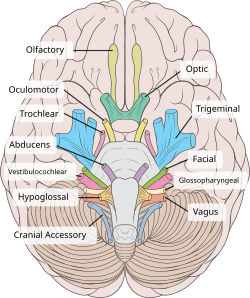Anatomy and Development of the Hypoglossal Nerve
- The hypoglossal nerve arises from the front of the medulla in the brainstem.
- It passes through the subarachnoid space and pierces the dura mater near the hypoglossal canal.
- After emerging from the hypoglossal canal, it gives off a meningeal branch and picks up a branch from the anterior ramus of C1.
- The nerve travels close to the vagus nerve and spinal division of the accessory nerve.
- It spirals downwards behind the vagus nerve and passes between the internal carotid artery and internal jugular vein.
- Neurons of the hypoglossal nucleus are derived from the basal plate of the embryonic medulla oblongata.
- The musculature they supply develops as the hypoglossal cord from the myotomes of the first four pairs of occipital somites.
- The nerve is first visible as a series of roots in the fourth week of development.
- By the fifth week, the roots have formed a single nerve and link to the tongue.
- Development of the hypoglossal nerve is essential for proper tongue function.
Function of the Hypoglossal Nerve
- The hypoglossal nerve provides motor control of the extrinsic and intrinsic muscles of the tongue.
- It innervates muscles involved in moving and manipulating the tongue.
- The genioglossus muscles are responsible for protruding the tongue.
- The hypoglossal nucleus interacts with the reticular formation, controlling reflexive motions.
- Corticonuclear fibers supply innervation aiding in unconscious movements related to speech and articulation.
Clinical Significance of the Hypoglossal Nerve
- Damage to the hypoglossal nerve is rare but can be caused by compression, trauma, or disease.
- Injuries to the nerve can result in difficulty with tongue movements, speech, chewing, and swallowing.
- Damage to the nerve can occur on one or both sides, leading to varying symptoms.
- The hypoglossal nerve is often affected in motor neuron diseases such as progressive bulbar palsy.
- Examination of the tongue and its movements can help diagnose hypoglossal nerve damage.
Use of the Hypoglossal Nerve in Nerve Repair
- The hypoglossal nerve can be connected to the facial nerve to restore function when the facial nerve is damaged.
- This connection, known as anastomosis, is used in cases of focal facial nerve damage.
- The connection of nerve fibers from the hypoglossal nerve to the facial nerve can be partial or complete.
- This procedure is often performed in cases of trauma or cancer affecting the facial nerve.
- The aim is to restore facial function by utilizing the intact hypoglossal nerve.
Other Aspects of the Hypoglossal Nerve
- The hypoglossal nerve is clinically implicated in the treatment of obstructive sleep apnea.
- Eligible candidates for the hypoglossal nerve stimulator implant are those who have failed continuous positive airway pressure therapy.
- The implant works by stimulating the tongue to protrude during inspiration, relieving tongue base obstruction during sleep.
- The hypoglossal nerve is found in amniotes, including reptiles, mammals, and birds.
- The evolutionary origins of the hypoglossal nerve have been studied in rodents and reptiles.
The hypoglossal nerve, also known as the twelfth cranial nerve, cranial nerve XII, or simply CN XII, is a cranial nerve that innervates all the extrinsic and intrinsic muscles of the tongue except for the palatoglossus, which is innervated by the vagus nerve. CN XII is a nerve with a sole motor function. The nerve arises from the hypoglossal nucleus in the medulla as a number of small rootlets, pass through the hypoglossal canal and down through the neck, and eventually passes up again over the tongue muscles it supplies into the tongue.
| Hypoglossal nerve | |
|---|---|
 Hypoglossal nerve, cervical plexus, and their branches. | |
 The hypoglossal nerve arises as a series of rootlets, from the caudal brain stem, here seen from below. | |
| Details | |
| To | ansa cervicalis |
| Innervates | genioglossus, hyoglossus, styloglossus, geniohyoid, thyrohyoid, intrinsic muscles of the tongue |
| Identifiers | |
| Latin | nervus hypoglossus |
| MeSH | D007002 |
| NeuroNames | 704 |
| TA98 | A14.2.01.191 |
| TA2 | 6357 |
| FMA | 50871 |
| Anatomical terms of neuroanatomy | |
The nerve is involved in controlling tongue movements required for speech and swallowing, including sticking out the tongue and moving it from side to side. Damage to the nerve or the neural pathways which control it can affect the ability of the tongue to move and its appearance, with the most common sources of damage being injury from trauma or surgery, and motor neuron disease. The first recorded description of the nerve was by Herophilos in the third century BC. The name hypoglossus springs from the fact that its passage is below the tongue, from hypo (Greek: "under") and glossa (Greek: "tongue").
hypoglossal nerve (plural hypoglossal nerves)